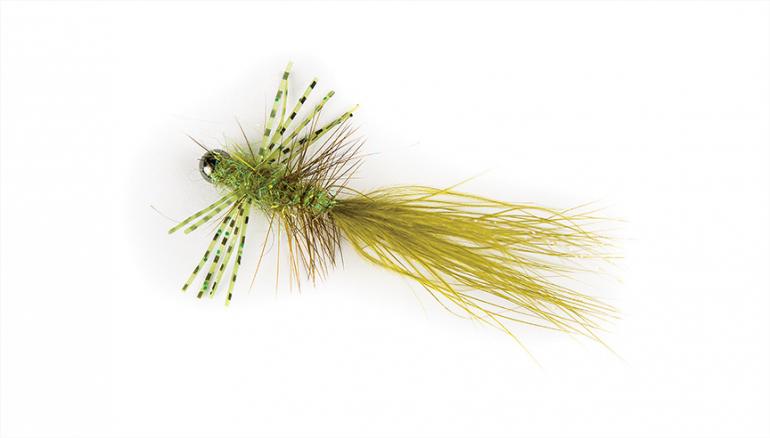Jiglet, Just a Little Bit
Winter's go-to fly.
The jiglet is a workhorse: a fly you can have confidence in any time of year, on almost any type of water. Originally it was designed to imitate small sculpins, but it’s one of those attractor patterns that can be used as a sculpin, crayfish, stonefly, or leach, depending on the color combination. It’s been one of my most consistent patterns on our local rivers—and in winter, when you’re freezing your butt off, you want to go with a proven performer.
Materials
Hook: Daiichi 4660, size 8
Bead: slotted Tungsten 5/32, black
Tail: olive Marabou and pearl Krystal Flash
Body: Hare’e ice dub olive and olive saddle hackle
Pectoral Fins: Sili legs nymph, olive-barred
Head: Dubbing loop with Hare’e ice dub olive
Thread: Uni thread 6/0, olive
Instructions
1. Start by adding the slotted Tungsten bead to the hook and then securing the hook to the vise.
2. Next, tie in the Marabou tail, cut off the excess, and tie in two strands of Krystal Flash on each side.
3. Tie in the saddle hackle feather (I like to use a feather with small barbs) and leave it hanging off of the back.
4. Now we’ll create the body using our dubbing. Apply some dubbing wax to your thread and then work your Hare’e Ice dub onto the thread making sure you have even coverage of the thread. Wrap forward until you are about 3/4 up the hook shank. Wrap the hackle up until you reach the end of the dubbing and cut off any extra feather you have.
5. After giving a few extra wraps to insure the hackle won’t fall apart, advance the thread a few wraps and add the rubber legs that will imitate the large pectoral fins of a sculpin. We do this by grabbing a clump of six rubber legs, holding the legs evenly over the top of the hook, making a few wraps over the top of them, then repeating this front to back instead of back to front. Essentially, you’re making an “X” over the top of the rubber legs.
6. Once you have the legs tied in you can work them with your fingers so that they both point out from each side of the hook shank. Then, advance your thread directly behind the bead.
7. The next step will include a dubbing loop. Create the dubbing loop behind the pectoral fins, then advance the thread to the bead.
8. Apply the dubbing wax to the loop and add the same Hare’e ice dub we used to dub the body earlier.
9. Spin the dubbing loop with a loop spin tool while periodically stopping and brushing out the dubbing.
10. Wrap the material forward, doing another figure-eight around the pectoral fins and then wrapping forward to the bead.
11. Using your thread, tie off the dubbing loop, cut off any excess material you have, and whip-finish the fly.
12. Cut the rubber legs on either side so that they are about as long as your thumbnail, then cut the Krystal Flash so that it’s even with the Marabou tail. Take a dubbing brush (a toothbrush works as well) and brush out the dubbed head so that it is even and make sure the pec fins match each other on either side.
You can tie this in many different color combinations; I’ve found green to be the best overall, but the black is a great sculpin, leach, or stonefly imitation. I also really like the rust-colored variation to imitate crayfish. If you don’t want this pattern to sink as fast as it does, you can tie it with a brass slotted bead. The Tungsten bead makes it get down quick, but it is difficult to float underneath a big dry fly and is best used under an indicator or fished as a streamer.
Jake Adelman is the general manager at Montana Troutfitters in Bozeman.











